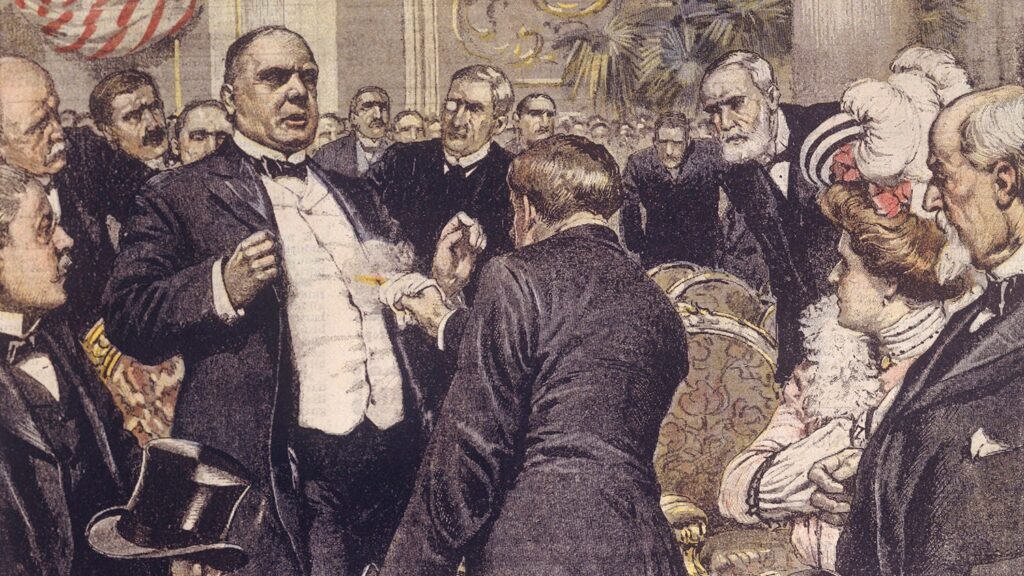In the early United States, most presidents operated under something called the “spoils system.” This meant that when new presidents took office, they often replaced federal employees who’d worked under a previous administration with loyalists from their own party. Federal employees could face firing if they didn’t demonstrate their fealty to the ruling party by obeying party bosses or donating money to campaigns. This wasn’t an official U.S. policy, but over time, it became an entrenched political norm.
Calls for reform of the spoils system increased with the growth of the federal government after the Civil War. It then came to a head when a disgruntled spoils system supporter shot President James A. Garfield for not giving him a job. The shooting led to Garfield’s death two months later, and helped convince his successor, Chester A. Arthur, to reform the civil service and begin dismantling the spoils system.
Spoils System Popularized Under Andrew Jackson
The term “spoils system” became popular during Andrew Jackson’s presidency. After Jackson took office in 1829, he removed a significant number of federal bureau chiefs, marshals, attorneys and other officers and replaced them with party loyalists.
Senator William L. Marcy of New York defended Jackson’s actions in 1832 by arguing that “to the victor belong the spoils of the enemy.”
Andrew Jackson’s Kitchen Cabinet
Jackson was not the first president to use the spoils system—Thomas Jefferson also removed many Federalists when he took power—and presidents after Jackson continued the practice. As the size of the federal government increased following the Civil War, a split emerged within the ruling Republican party between those who wanted to reform the spoils system, and a faction of the Republican party, known as the Stalwarts, who wanted to keep it.
Reformers argued that the spoils system elevated “people purely based on their political orientation, and more importantly their political loyalty, instead of people who are actually qualified to do the jobs,” says Scott S. Greenberger, executive editor of Stateline and author of The Unexpected President: The Life and Times of Chester A. Arthur. They also argued that worker turnover with every party change made it difficult for federal employees “to develop any sort of expertise.”
The spoils system became a hot political topic, drawing attention from one of the country’s leading writers and humorists. In 1876, Republican Rutherford B. Hayes ran for president on a platform that included reforming the spoils system. That year, Mark Twain—who had just published The Adventures of Tom Sawyer—campaigned for Hayes and made a speech in favor of civil service reform.
“We will not hire a blacksmith who never lifted a sledge,” Twain said. “We will not hire a schoolteacher who does not know the alphabet… But when you come to our civil service, we serenely fill great numbers of our minor public offices with ignoramuses.”
Hayes was unsuccessful in his attempts to end the spoils system. The next president, James A. Garfield, was another Republican who appeared to be pro-reform, while his vice president, Chester A. Arthur, was a known Stalwart. However, Arthur ended up changing his stance after a Stalwart shot Garfield—an event that had a huge impact on the movement for civil service reform.
Garfield’s Assassin Motivated by Spoils System
During Garfield’s 1880 presidential campaign, a man named Charles Guiteau made a couple of small contributions: he wrote a pro-Garfield pamphlet and made a brief speech in the candidate’s favor. Despite this limited involvement, Guiteau believed that he had played an outsized role in winning Garfield the election. Guiteau wrote to Garfield and other officials stating that as a reward, he would like to be a U.S. diplomat to France or Austria—the country varied from letter to letter.
When Guiteau did not receive an appointment, he grew angry, and decided on a plan. If he assassinated Garfield, a Stalwart would be president, and he believed this would heal the Republican divide over the spoils system and ensure the system’s protection.
On July 2, 1881—just four months into Garfield’s presidency—Guiteau shot the president at a railway station in Washington, D.C. Officers arrested Guiteau, who reportedly told one of them: “I am a Stalwart, and Arthur will be president.”
Assassination Backfires, Reforms Introduced
Guiteau was right that Arthur would be president, but not immediately. Garfield didn’t die until September 19, over two months later. Arthur was horrified by the shooting and Garfield’s long medical ordeal, and disturbed by speculation in the press that he had colluded with Guiteau to kill Garfield in order to advance the Stalwart agenda. Contrary to what Guiteau had hoped, the shooting increased political support for reform, including with the man who became president.
On January 16, 1883, Arthur signed the Pendleton Civil Service Act. This created the Civil Service Commission and established Civil Service Examinations as the basis for hiring for certain positions, rather than party loyalty. At the time, this act only applied to about 10 percent of the federal government’s 132,000 employees, but it was the beginning of a series of measures that dismantled the spoils system.
During Grover Cleveland’s two nonconsecutive terms, he expanded the scope of the Pendleton Act to cover more than 40 percent of federal jobs. In 1939, the United States passed the Hatch Act, which restricted federal employees’ participation in political campaigns.
The last major law to reform the civil service was the 1978 Civil Service Reform Act, which established the Office of Personnel Management, the Merit Systems Protection Board and the Federal Labor Relations Authority. By 1980, the Pendleton Act applied to the majority of federal jobs.


